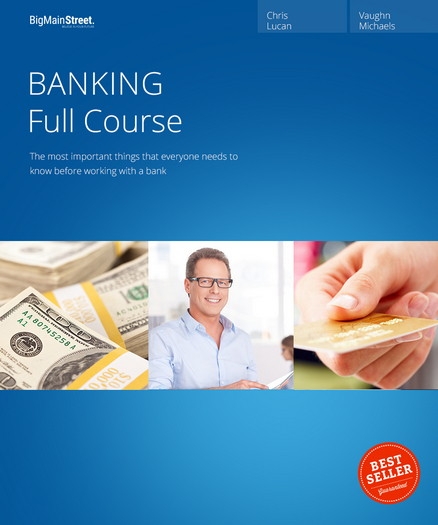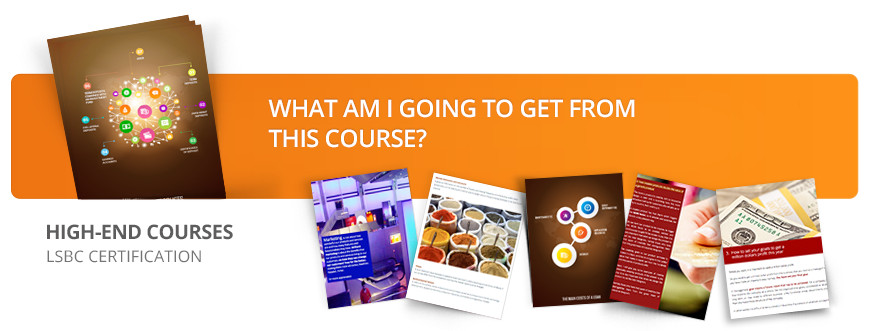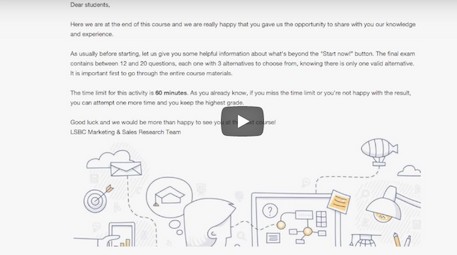
Certified By:
Discover how you can stop losing money when dealing with banks! These days we have within our grasp a diversity of financial and banking products meant to make our life easier when we have to make a payment, finance our business or buy the things we want.
The vast experience of the banking and finance professionals with whom we’ve closely worked on this banking online course proved that people often spend a lot of money on fees and interests because they either don’t choose the right product or use that product in a disadvantageous way.
One of our collaborators, an experienced financial advisor, told us once: “It’s really unbelievable how much money people lose when they get a loan, use a credit card or make a wire transfer, just because they don’t pay the proper attention to those things that could help them save that money.”
The Retail & Corporate Banking Course can help you become a banking professional or a financial professional with extensive knowledge in banking.
You will know how to:
- Get a loan also when your revenues are not enough
- Understand what underlies the bank’s decision of lending money
- Choose the right term deposit knowing what interest capitalization and automatic renewal imply
- Easily calculate the bonus interest for your term deposits
- Use the domestic intrabank and interbank wire transfers and the international ones
- Cash a check, endorse a check and what to do when you lose your check or it’s stolen from you
- Properly use the prepayment, the open account, the documentary collection and the letter of credit as payment
- Methods used in foreign trade transactions
- Use bank cards for minimizing risks and costs of banking
- Effectively use internet banking and mobile banking to cut the costs
- Choose the amortization schedule that suits you best
- Get a bigger loan and use credit cards in order to pay a lower interest
- Use the lines of credit, the factoring and the letter of guarantee
- Choose between the financial and operational lease according to the particularities of your business
- Use the “Sale and lease-back” in order to get the cash you need
…and so much more
Who is this Banking course for?
The Retail & Corporate Banking Online Course is perfect for:
- Young people eager to pursue a career in Banking
- Professionals working in Finance or Banking
- Financial advisors interested in learning more on how they can advise people on their finances
- People who want to change their financing and budgeting
- Anyone who has a bank account, uses checks, makes wire transfers, pays with credit cards, uses mobile banking and internet banking
- Those who need a personal loan, a business loan or a lease
No prior knowledge is necessary.
Career Path - The Retail & Corporate Banking Course allows you to fulfill various roles, including:
- Branch Manager, Branch Coordinator
- Personal Banker, Loan Manager
- Credit Analyst, Portfolio Manager
- Operations Officer, Loan Officer
Module 1 - How to Understand Banking Operations and the Functionality of the Bank Account
1.1 What is the bank account, bank account types and how we can use them
1.2 How it works and what operations we can make when using the checking account
1.3 How we can easily understand the debit and credit balance of the checking account
1.4 What is the statement of account and for what it is useful
1.5 What is direct debit and how we can use it
1.6 What documents you need to open a checking account
1.7 The interests and fees for a checking account
1.8 How to close a checking account
1.9 What are the advantages of using a checking account
Module 2 - What We Need to Know About Saving and Bank Deposits
2.1 What is a bank deposit and how to open it
2.2 What is the difference between a national and a foreign currency deposit
2.3 Term deposit, renewal and interest capitalization
2.4 Term deposit with fixed and variable interest rate
2.5 A concrete example to understand better how to calculate the interest
2.6 When we can use the certificate of deposit
2.7 What involves the deposit liquidation before maturity
2.8 What are the hybrid saving products
2.9 What we need to know when we want to save money by buying gold
Module 3 - The Wire Transfer
3.1 What is the wire transfer and what it is useful for
3.2 What are the types of wire transfers
3.3 What are the steps of a wire transfer
3.4 What is the practical circuit of the interbank transfer
3.5 What information should contain the wire transfer form
3.6 How to make an international wire transfer using SWIFT and how to pay the fees
3.7 When we can use the conditional wire transfer
3.8 What is and when we can use the Standing Order
Module 4 - The 10 Most Important Things We Should Know About Checks
4.1 What is a check and who is involved in its clearing
4.2 How we use a check
4.3 What are the most common types of checks
4.4 How to fill in correctly a check
4.5 How to cash a check and what is the cashing circuit
4.6 What we can do if we lost a check or it was stolen or destroyed
4.7 The reasons why a check can be declined
4.8 What to do if we are the payee of a declined check
4.9 What is check endorsement and how to do it
4.10 What is check guaranty and what it is useful for
Module 5 - The Payment Methods Used in Foreign Trade Transactions
5.1 What we should be aware of when we choose the foreign payment method
5.2 Prepayment. How to do it and what are the risks for the importer
5.3 The open account. What it means and what are the risks for the exporter
5.4 What is the documentary collection and who are those involved in its development
5.5 The reasons we should choose the documentary collection for foreign payments
5.6 What are the documents presented by the exporter to their bank for the documentary collection
5.7 How the documentary collection takes place
5.8 What is the letter of credit and who are those involved in carrying it out
5.9 What are the reasons why we should use the letter of credit
5.10 What are the types of letters of credit and which one is right for us
5.11 The documents presented by the exporter to their bank for the letter of credit
5.12 How the operations for the letter of credit take place
5.13 What are the advantages and disadvantages of the letter of credit for both importer and exporter
5.14 What are the differences between the documentary collection (DC) and the letter of credit (LC)
Module 6 - How to Use Better the Cards, Internet Banking and Mobile Banking
6.1 What is the use of a bank card and how it works
6.2 What it must be inscribed on a bank card
6.3 What are the types of bank cards
6.4 What is very important to know when we get a bank card
6.5 How to choose the best bank card considering its costs
6.6 What we need to know when we use the bank card in everyday life
6.7 What we should do if we cannot withdraw the money from the ATM
6.8 What we should do if we lost our card or it was stolen
6.9 How to use the internet banking service
6.10 Why we should use Mobile banking
Module 7 - The Most Important Things to Know About the Loans for Individual Customers
7.1 What implies taking a loan from a bank
7.2 What we can do with the money from the loan
7.3 What are the conditions we need to fulfill in order to get a loan
7.4 How the bank sets the maximum amount we can receive as a loan
7.5 What are the documents requested by the bank for preparing a loan application
7.6 What contains the loan application form
7.7 What are the supporting documents that prove the loan purpose
7.8 What is the down payment and for what kind of loans it can be requested
7.9 What solutions we have when our revenues are not enough to get the loan
7.10 What is the guarantor and how they can help us
7.11 What are the guarantees the bank could ask for
Module 8 - What Type of Loan Suits Us Best and How to Lower Our Costs
8.1 What are the main costs of a loan that you have to pay
8.2 How to understand better what is an installment made of
8.3 How to calculate the interest
8.4 What type of amortization schedule is the best and we should choose
8.5 What is the grace period and when we can get it
8.6 How we can get a bigger loan
8.7 What currency is more advantageous when we take a loan
8.8 What you need to know about the loan for personal needs
8.9 How to use credit cards in order to pay a lower interest
8.10 How a car loan can be given easier
8.11 What we need to know about the mortgage loan
Module 9 - What You Need to Know About Business Lending
9.1 How and in what situations we can use the bank loan to support our business
9.2 What underlies a bank\'s decision to grant us a loan or not
9.3 What are the documents required by the bank for the loan application
9.4 What is the start-up loan and for what it is useful
9.5 How we can get a loan for financing our current activity
9.6 In what situations we can get an investment loan
9.7 When we need a letter of guarantee
Module 10 - The Lease
10.1 What lease means and what are the parties involved in its running
10.2 The 11 key terms you have to know when you get a lease
10.3 What you can lease
10.4 In what situations we can choose the financial and operational lease
10.5 How to use to our advantage the differences between the financial and operational lease
10.6 What is important to know about the direct lease and the sublease
10.7 What are the “Sale and lease-back” and the “Buy-back”
10.8 What guarantees may be required by the lease company
10.9 How a lease operation runs
10.10 How we can transfer a lease agreement to another user
10.11 What happens if we don’t pay the lease installments
10.12 What are the reasons why we would choose lease as a means of financing

- 197 course pages in a premium business magazine format that you can easily print
- 29 real-life examples with extra knowledge from the most experienced professionals
- 15 high-quality infographics that help you understand everything easier and quickly
- 44 real cases practical applications with role-playing for easily putting into practice everything you learn
- Feedback for every answer and option you choose on the real cases practical applications
- Full Guidance & Support
- Graduation Certificate downloadable as pdf and optionally the printed version
Can I find a job easier by graduating the Retail & Corporate Banking Course?
By signing up for this banking online course, you will engage in a superior training program devised by banking specialists and you will acquire the banking expertise that will definitely help you differentiate from other candidates when you will apply for a job or a promotion.
Your benefits
- High-quality course delivered in a premium business magazine format through engaging and captivating content.
- Instant access to up to date valuable knowledge from experienced professionals from banking, finance and financial counselling that you can put into practice immediately.
- Clear and concise language, easy to understand regardless of the complexity of the topic.
- Real-life case studies offering role play, seamlessly putting into practice everything you learn.
- Captivating infographics, illustrating key points that help you understand and remember quickly and easily.
- Relaxed course schedule - you are free to organize your time as you wish and you can learn at your own pace 24/7 from anywhere in the world.
- Stress-free assessment methods - you can repeat the course activities until you’re happy with the results.
- Amazing customer service and administrative support from the moment you enroll until you complete your course.
- Banking Certification - instantly download your graduation certificate as a pdf or get the official printed version.
- Accessible learning – for this banking course you don’t need previous experience or certain qualifications to enroll.
- User-friendly online learning platform – simple and easy to use for everyone.
- Great value for money - premium banking course at the most affordable price.
How to learn and get results faster
After you go through the checkout process, in a few minutes, in My Account you can click the link Go To My Courses and you’ll find your online courses, along with each course schedule.
Each module has 1 or 2 learning sessions. You get a new module every week and from that moment you have 3 weeks to participate in the Course Activities.
You are free to organize your time as you wish and your courses are available 24h/day and you can study at your own pace.
You will get feedback and points that will contribute to your Final Grade.
Here is a quick step by step video about how to learn:
Anytime you have questions, feel free to open a support ticket or a live chat. Also, you will have a tutor who will watch over your course progress and will send you notifications by SMS or email when needed.
Because we want you to be happy with your results you can always attempt every online course activity at least 2 times, even the final assessment.
In the end, you will attempt the final assessment in order to finish the course. Because the practical applications are the most important part in the learning process, the final assessment questions are quite easy to answer and the final assessment is only an official requirement, not a stressful exam.
After you finish your course, you can go to your account in My Certificates section and download your graduation certificate and the transcripts for free. You can also order right away, the International Certification that comes printed.
As you can see, learning with us is easy, not time-consuming and you can achieve your goals faster.
How long will it take to complete the Retail & Corporate Banking Course?
The course takes 12 weeks and every week we recommend you to spend 3 to 5 hours learning and participating in your course activities, any day and time that suits you best.
How will I be assessed at the Retail & Corporate Banking Course?
You can take this online course even without being assessed. You decide how much you are willing to engage in your course. However, if you want to receive the Banking Certification, meaning the certificate of completion, you have to get a pass mark (minimum 5/D) as a result of your participation in the course activities.
After each module, you will participate in real case simulations and practical applications in order to apply what you’ve just learned to actual real-life situations. You will receive feedback for every solution you propose.
In the end, you will attempt the final assessment in order to finish the course. Because the practical applications are the most important part of the learning process, the final assessment questions are quite easy to answer and the final assessment is only an official requirement, not a stressful exam. You don’t have to pay anything for the assessment.
Full Guidance & Support
When you enroll in the Retail & Corporate Banking Course with BigMainStreet, you will have a Tutor who will watch over your course progress and will send you notifications by phone or email whenever it will be necessary.
Requirements
- There is no previous experience or qualifications required for enrollment in this banking online course. It is available to all students aged 18 or over, of all academic backgrounds.
- Basic understanding of English language is required to attend the Retail & Corporate Banking Course.
- You’ll need a computer or tab with an internet connection.
By enrolling to this course you can collect up to 18 loyalty points. Your cart will total 18 points that can be converted into a voucher of $18.
Reviews












